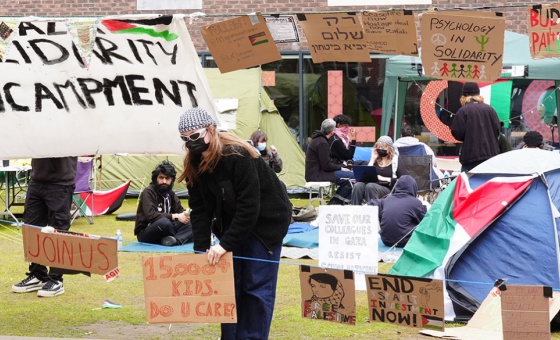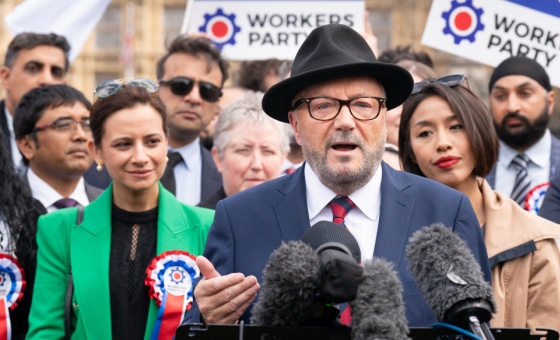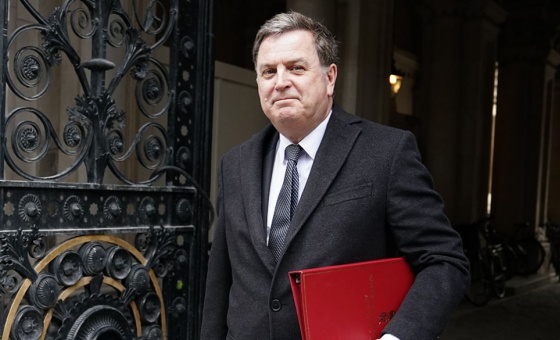This is the last article you can read this month
You can read more article this month
You can read more articles this month
Sorry your limit is up for this month
Reset on:
Please help support the Morning Star by subscribing here
ABUNDANT attention was given to the increase in strikes in the US during “Striketober” and “Strikevember” last fall, catchy terms for months when many strikes were expected to occur.
They not only turned out less than impressive but were matched by the fact that at least as many workers were also involved in making credible strike threats.
What, exactly, is a credible strike threat? First, it has to be credible to the boss. The boss needs to know that the workers will take escalating actions leading to a strike, and that a supermajority of members have publicly committed to strike, have a strike fund, and have widespread public support.
This tells the boss that meeting the workers’ demands now is less costly than dealing with a strike in the future.
Second, the strike threat has to also be credible to the workers. If not enough union members publicly commit to striking, the leadership is not committed, or the strike end date is announced before the strike has even begun, few workers will find it credible and they will not be willing to strike.
Labour organisers Helena Worthen and Joe Berry define strike threats as follows: “It is essentially a display of power. It can also expose the union to a serious risk, because if it has to be carried out and doesn’t get what was desired, it becomes a public record of weakness.”
Despite the hype, during these two months, credible strike threats by University of California lecturers, Hollywood and TV workers, and an alliance of 22 nurse and staff unions at Kaiser Permanente in California and Oregon, demonstrated that workers are quietly organising strike threats that may be as or more effective than striking to get the goods.
Class is in session: UC lecturers teach us about credible strike threats
In 2020, after bargaining for one and a half years, much of the time during an expired contract, the UC-AFT, which represents 6,500 non-senate faculty members and librarians, began an organising campaign for lecturers, who are non-tenured and teach one-third of University of California (UC) undergraduate classes.
The lecturers initially issued a threat for a two-day strike against unfair labour practices in October, which led the UC to begin to move on the union’s demands.
To provide more time for bargaining, the two-day strike was then postponed to November, but was called off when the UC and the union reached a settlement in the middle of the night before the day of the strike.
As a result, a historic settlement was reached, which dramatically improved the pay and job security of untenured lecturers, who are low-paid and often not rehired after one year.
This was the UC-AFT’s first credible strike threat since it last struck in 2002. For UC-AFT vice-president Trevor Griffey, speaking in an interview, “this is a really big deal for our union that we even did strike organising at all.”
As part of the strike threat, UC-AFT members crashed bargaining sessions, which are typically closed, forcing them to be opened to the public.
Informational pickets and two nearly unanimous votes for an unfair labour practices strike made the strike threat credible to the University of California.
Just as UC-AFT members were about to escalate their tactics, the University of California conceded to their demands and even increased their settlement offer. The lecturers’ strike threat was credible to both the university system and UC-AFT members.
Counting strike threats
The tracking of strikes is limited and research on strike threats is almost non-existent. While the US Bureau of Labour Statistics (BLS) does track strikes, the bureau is significantly under-reporting strike activity in the United States by only reporting strikes involving 1,000 or more workers, even though only 0.3 per cent of US businesses have 500 workers or more.
Because the BLS only counts a tiny minority of all employers, it significantly undercounts the number of strikes that happen each year.
Using public news sources and government reports, my research assistant and I found 134 reported strike threats between 2012 and 2016.
Of these, 97 strike threats were settled without a strike in firms of any size workforce, involving a total of 701,700 workers.
Of the 134 strike threats, 73 occurred in workplaces with fewer than 1,000 workers. Of these 73 strike threats, 20 resulted in strikes involving 8,573 workers, six had an unknown outcome at the time of the study, and the remainder resulted in no strike.
We did not assess whether the strike threat was “credible,” which would be useful to do at some point in the future.
For the same 2012-16 period, the BLS reported 72 strikes in firms with 1,000 or more employees involving 352,000 workers.
In addition to the number of workers threatening to strike being nearly twice the number that actually did strike, the number of threats was 134.7 per cent higher than the number of strikes during this time.
The BLS doesn’t count strike threats and continues to refuse to count them even after I asked them to do so. For this reason, I launched strikethreats.org for rank-and-file union members and union officers to report their strike threats.
Striketober and Strikevember?
Comparing strike reports by the BLS and the Cornell School of Industrial and the Labour Relations’ Labour Action Tracker for the months of October and November 2021 give starkly different results.
The BLS shows only three strikes occurring during these two months, involving a total of 5,400 workers. In contrast, the Labour Action Tracker reports 60 strikes just in October involving 18,700 workers, and an additional 47 strikes in November involving 62,000 workers for a total of 85,830 workers — 15 times the number of workers reported by the BLS.
However, it is important to note that the Labour Action Tracker reported only three strikes in October involving more than 500 workers, which accounted for two-thirds of the strikers during that month, and 75 per cent of the strikers in November were involved in just three strikes involving more than 330 workers.
While the Labour Action Tracker shows a substantially higher number of workers on strike than the BLS, its estimate of workers engaged in strike-related activity is still too low.
While the Labour Action Tracker counts, respectively, 58 and 42 other “labour protests” for October and November (which the Labour Action Tracker project co-ordinators tell me may include strike threats) it doesn’t tell us how many resulted in settlements.
By comparison, a minimum of about 78,500 workers (as many as 60,000 to 80,000 nurses and staffers joined this group when they ratified a contract with their employer in December 2021) were involved in the three largest known settled strike threats by University of California lecturers, Hollywood and TV workers, and an alliance of nurse and staff unions at Kaiser Permanente during these two months.
This means that there were at least nearly twice as many workers engaged in strike-related organising than has been reported by the Labour Action Tracker, and 30 times the number reported by the BLS.
While the Labour Action Tracker is a far more reliable source, neither captures an accurate level of strike-related organising activity.
The strikes during these two months were extremely small and localised and, as a result, had a limited strategic impact. They were unlikely to have contributed to more workers striking because they did not occur at choke points in transport or logistics or spread along the supply chain.
Strikes are not only prohibited by contracts but also constrained by labour law for unionised workers. Just announcing that more workers will strike will not result in more workers actually joining them.
Larger strikes take a long-term organising effort to overcome strike hesitancy among union leadership and members, build majority participation, and use escalating tactics in order to strategically spur strikes in other related workplaces and industries.
The focus on any strike is a narrow strategy. We certainly want to see more strikes, but we also want to see more that have a systemic strategic impact.
But we still need to pay attention to the many workers engaged in strike organising campaigns that win some or all of their demands by mounting a credible threat to strike.
Why credible strike threats matter
The severe undercounting of workers organising for strikes continues to skew the facts about the level of worker organising throughout the United States by giving the misperception that workers are not interested in or even attempting to strike.
Labour law, employer repression, automation, and unions’ abandonment of organising has clearly resulted in a continuing decline in the number of strikes. But strikes are not being correctly measured, or they are viewed as the only measurement that matters.
By counting strike threats, especially those that are credible enough to be settled on favourable terms to the workers before the strike occurs, we can see how more workers are increasingly restless and engaging in more potentially disruptive struggles than we have been led to believe by the government, academia, union leadership and the media.
Robert Ovetz is a senior lecturer in political science at San Jose State University, labour scholar, and union organiser. He is editor of Workers’ Inquiry and Global Class Struggle: Strategies, Tactics, Objectives (Pluto, 2020). His writings can be found at: sjsu.academia.edu/RobertOvetzPhD Report your strike threat at strikethreats.org.
This article first appeared at Dollars & Sense, April 2022, (www.dollarsandsense.org).











